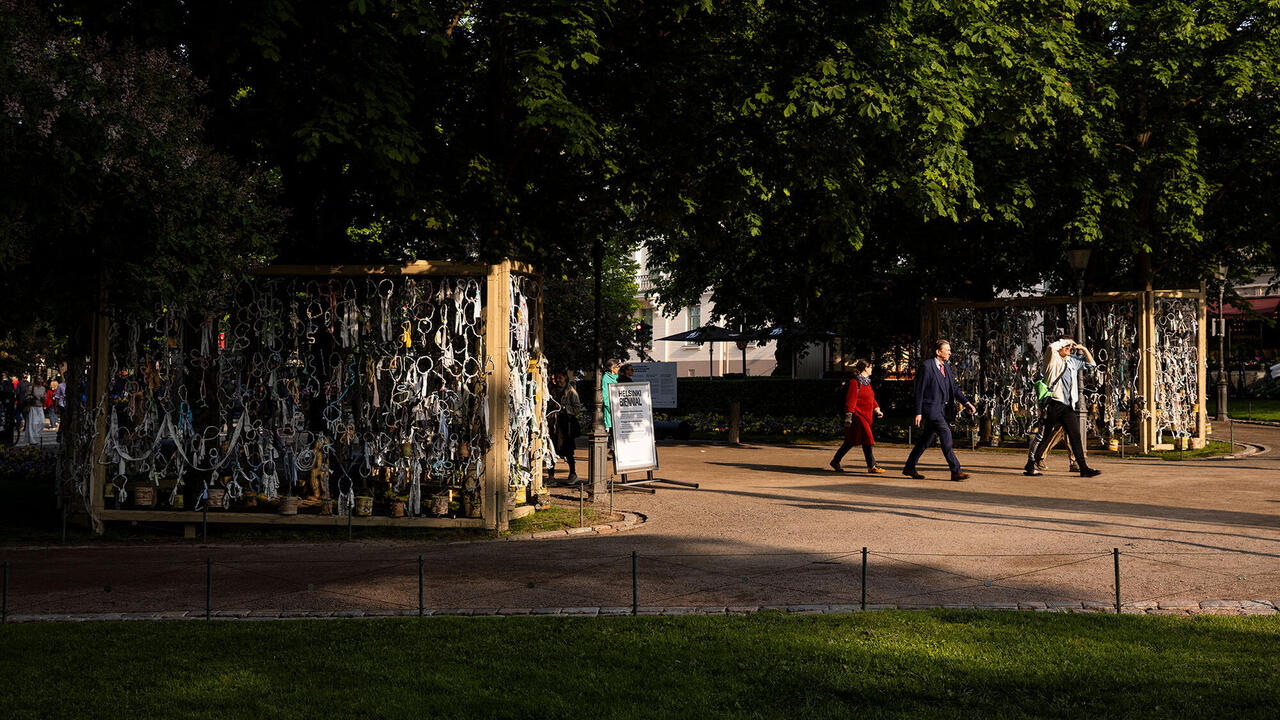Salon der Angst
Kunsthalle Wien
Kunsthalle Wien

JÖRG HEISER Nicolaus Schafhausen’s first year as director of the Kunsthalle Wien has not been easy. He decided that the Kunsthalle needed to be reformatted before starting a regular programme of exhibitions. And rightfully so: under his predecessor, Gerald Matt, the entrance area looked like a provincial Austrian business lounge with a souvenir shop attached. Now the entrance has been unclogged. With his first exhibition, Salon der Angst (Salon of Fear), Schafhausen has made full use of the museum space (jointly curated with Cathérine Hug, who is departing for the Kunsthaus Zürich).
The Vienna rumour mill and some quarters of the Austrian media greeted the period of renovations and the event series What would Thomas Bernhard do? with whispers and murmurs. Die Presse particularly excelled at anticipatory malicious gloating, while at the same time also lambasting Schafhausen’s ‘German compatriot’ Karola Kraus at the neighbouring mumok. There were tones of crypto-fascist physiognomism in the way some people – for example, in Der Standard’s reader comments – held forth obsessively on the subject of Schafhausen’s eyebrows. Some in the Viennese art audience apparently sought to reinterpret the concept of German Angst as fear of the Germans. So Salon der Angst fits like a glove. It’s a brilliant title: the fearless open-mindedness expected of a bourgeois intellectual salon suddenly appears tainted.
DOMINIKUS MÜLLER One finds fear in the exhibition wherever one looks for it: in abandoned buildings (Didier Faustino, Exploring Dead Buildings, 2010), in images of twisted, eerily immobilized bodies (Özlem Altin’s Thin memory (gestures of touching or leaving), 2013), in pop cultural myths (Cameron Jamie’s Front Lawn Funerals and Cemeteries, since 1984), in colonialist fantasies of the monstrous Other (Kader Attia’s The Culture of Fear: A Construction of Evil, 2013) and in Austrian art history (Marcel Odenbach’s Außer Rand und Band [Going Wild, 2012] – featuring archival footage from the Aktionsanalytische Organisation by Otto Muehl). Fear is presented as something with social causes. It is always the concrete ‘fear of…’ stoked by ideology and the media. At the same time the sheer variety of these causes renders fear omnipresent: it becomes almost an anthropological constant – making it intangible and as virtually arbitrary as the exhibition’s subject.
This tension becomes clear in view of the exhibition’s two historical anchors. Ferdinand van Kessel’s tableaux Ansichten aus den vier Weltteilen mit Szenen von Tieren. Amerika and Europa (Views of the Four Continents with Scenes of Animals: America and Europe 1691 and 1689) seek to impose a hierarchical order of classification and a literal framing of the ‘newly discovered’, threateningly-foreign world beyond Europe, and thereby keep fear at bay. By contrast, James Ensor’s turn-of-the-century miniatures of billiards-playing skeletons and nightmarish demons send shivers down your spine. Salon der Angst is caught between these two points: on one side, a contextualization that runs the danger of ‘explaining away’ its subject by locating it concretely; on the other, an emphasis on atmospheric effects that slide into generality. It’s a contradiction that one cannot resolve, only withstand.

JH As far as historical works are concerned, Alfred Kubin’s drawings also need to be mentioned: like Ensor, he deals with issues of fear, but his works feel more instructive for the here and now. Several mythological motifs are joined together in Der Bräutigam (Rhinocerus und Jungfrau) (c.1903–04, The Bridegroom: Rhinoceros and Virgin): the black rhinoceros above the helplessly sprawled virgin is reminiscent of the classical myth of Zeus and Europa. At the same time, the rhinoceros represents exotic foreignness; it signals xenophobia and the colonial era. From Kubin, fear as a spectre fed by populism appears in Marko Lulić’s black and white mobile phone photos of banal Vienna street scenes, whose titles suggestively link them with violent stories from the tabloid press – for example, Orte der Angst (Wien, Simmeringer Hauptstraße, Krone, 20.06.13) (Places of Fear [Vienna, Simmeringer Hauptstraße, Krone, 20 June 2013], 2013).
With Kubin, Lulić and Los Carpinteros in mind, it is easy to be reminded of the recent Austrian election campaign, which was dominated by right-wing populism – that is, by fear-related topics such as immigration and Euroscepticism – and which took place around the time of the exhibition opening. The fear of bodily decline and loss of virility that is expressed in Los Carpinteros’ work (Pellejo, 2013) corresponds to the 81-year-old billionaire and National Council candidate Frank Stronach’s display of his naked torso (‘Look, I’m still fit!’), to which 44-year-old right-wing populist Heinz-Christian Strache responded with a picture of himself in swimming trunks. The latter also presented himself on Freedom Party (FPÖ) posters with the inimitably perfidious slogan ‘Love thy neighbours – mine are our Austrian people’. Could the exhibition have reacted more sardonically and aggressively to these trends?
DM It certainly wouldn’t have been right to react to fear mongering with provocation and alarmism. Lulić’s series, which features in the exhibition almost as a leitmotif, gets to the heart of this particular mixture of stupidity, harshness and right-wing populist hysteria with its references to Vienna as a concrete place and to the Austrian tabloid press. It’s always said that you need to face up to your fears and look them in the eye. This means taking them seriously and looking for the reasons behind them. And that’s very much possible at the Salon der Angst.
Translated by Jane Yager
















